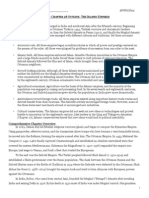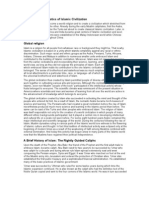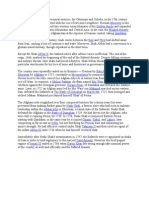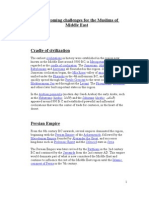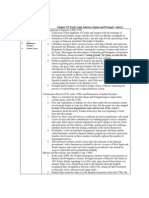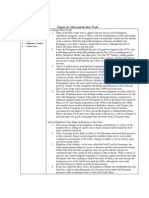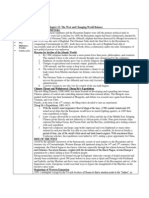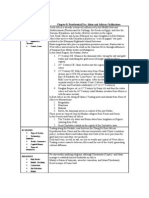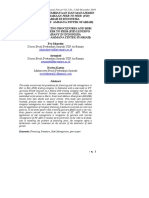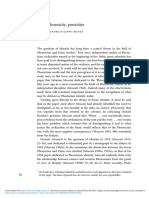Andrew Yang Period 7 Persian Chart AP World History Chapter 20: The "Gunpowder Empires"
Andrew Yang Period 7 Persian Chart AP World History Chapter 20: The "Gunpowder Empires"
Uploaded by
apwhhchsCopyright:
Available Formats
Andrew Yang Period 7 Persian Chart AP World History Chapter 20: The "Gunpowder Empires"
Andrew Yang Period 7 Persian Chart AP World History Chapter 20: The "Gunpowder Empires"
Uploaded by
apwhhchsOriginal Title
Copyright
Available Formats
Share this document
Did you find this document useful?
Is this content inappropriate?
Copyright:
Available Formats
Andrew Yang Period 7 Persian Chart AP World History Chapter 20: The "Gunpowder Empires"
Andrew Yang Period 7 Persian Chart AP World History Chapter 20: The "Gunpowder Empires"
Uploaded by
apwhhchsCopyright:
Available Formats
Andrew Yang Period 7 PERSIAN Chart AP World History
POLITICAL Leaders, Elites State Structure War Diplomacy, Treaties Courts, Laws
Chapter 20: The Gunpowder Empires The Ottoman Empire 1. Turkic speaking peoples from central Asia had originally had great influence on the political decisions of the old Abbasid caliphates; when the capital at Baghdad was sacked in 1258, the way opened for the Ottoman Turks to push through and take the mantle of leadership. 2. The Ottomans under Osman in the late 13th Century migrated to the Anatolian plain and began their series of conquests throughout the Middle East. 3. By `1350, the Ottomans had advanced from Asia Minor across the Bosporus straits into the Balkan Peninsula. By 1400, Thrace along with most of the Balkan Peninsula had been conquered. After a short civil war, Mehmed I gained control of the Ottoman territories and became sultan. The one spot left to conquer in the Balkan Peninsula was the Byzantine stronghold of Constantinople itself. 4. For seven weeks, Mehmed II led his massive army on a siege of Constantinople, finally crippling its defenses with artillery fire and vastly outnumbering the Byzantine defenders. Constantinople was sacked and plundered. 5. In the centuries afterwards, Ottoman armies under a succession of good rulers extended the empire into Syria and Egypt, as well as reaches of North Africa. Hungary also fell under the Ottoman sphere of influence. Powerful navies captured Rhodes, Crete, and Cyprus for crucial navy bases. One of the turning points that halted Ottoman expansion and started the empires steady decline was the siege of Vienna in 1683 that failed against more superior military technology. 6. As soon as Constantinople was sacked and pillaged, Mehmed restored it to its glory and made it the Ottoman capital of Istanbul, from which all the following rulers, called Sultans, would rule. Early sultans handed down political administration powers and commanding of the army to their future successors, thus ensuring that the future Sultan would be prepared for his new task of ruling the empire (key to Ottoman success politically for the first few centuries). Also, the strong army was made up of slave boys called janissaries, who were educated and converted to Islam; these gained power as the new bureaucracy that challenged the authority of the Turkish warrior aristocracy. Additionally, the sultans had chief advisers called viziers who managed most of the administrative affairs of the empire. 7. After the able rule of Suleiman the Great in the 17 th Century, Ottoman rule began to lose its grip on Europe, receding from its previous military might and plagued by delusional and ineffective rulers. It finally disintegrated after World War I. The Safavid Empire 1. Originated from a family of Sufi mystics based at Ardabil in the Caspian Sea region in the 14th Century; Sail al Din began a military campaign to purify Islam and spread Shiite doctrine to Turkish tribes in the region. 2. The new Red Heads under the commander Ismail led his followers to a string of victories, starting with the capturing of Tabriz and establishment of the ruler called a shah in 1501. The next decade was filled with conquests of the Ozbeg rivals and violent conquests in present day Iraq and Iran through the conquering of Baghdad in 1508. Obviously, the Safavids were intruding on Ottoman territory, because the two armies, Sunni Ottomans against Shiite Safavids, clashed at the battle of Chaldiran. The Safavids lost and had to retract their territory back to the borders of present day Iran. 3. After the defeat, Turkish chiefs decided to plot for the throne and take over the empire; they were thwarted by the efforts of the next shah Tahmasp I, who restored the former glory of the empire. His successor Shah Abbas I left the Safavid Empire at its highest peak of prosperity and strength, bringing the chiefs
4.
under control and making use of captured slaves for conscription to his armies, much like the Ottoman state. Abbas had very useful European advisors who could inform him on how to develop and advance his military technology, but they didnt last after his death. Abbas had an elite group of 40000 troops and an elite bodyguard during his rule. The imperial bureaucracy was staffed with many of his Persian supporters and janissary like slaves. The capital was moved from Tabriz to Isfahan. The empire rapidly declined in the 16th century because successive shahs became disconnected with the public and were too weak to rule. Able shahs were too few and far between. Nomadic invasions and Mughal and Ottoman incursions further shrunk the size of the empire. Finally, in 1722, the capital was overrun by Afghani tribes. Though there was a short revival, the empire was reduced to a battleground for its neighboring enemies.
ECONOMIC Type of System Technology, Industry Trade, Commerce Capital/Money Types of Businesses
The Mughals in India (Before the British came) 1. The Mughal Empire derived from Timurs old territories based in Samarkand. His relative Babur lost his home kingdom of Ferghana in central Asia and decided to lead his followers into India to form the third Muslim empire. In 1498, Babur was in a power struggle with the Ozbeg tribes driven out by the Safavids, and he was pushed back to Kabul in 1504. Gradually, Babur was jolted to reality about regaining Ferghana, and he led his highly outnumbered, but technologically superior, army of 12000 soldiers to meet the Muslim Lodi army of 100000. At Panipat, the armies clashed and Babur was victorious. The next year, Babur defeated the confederation of Hindu warrior kings near Agra, and within the next two years, the Mughals had established a dynasty of rulers that controlled large portions of the Indus and Ganges river plains. Babur decided not to change the very ineffective Lodi bureaucracy, and in 1530, he died very early, leaving power to his son Humayan. 2. Humayan got entangled in a dispute over who was the legitimate successor of Babur, and armies from Afghanistan and the Rajput states of western India marched on his armies and forced him to spend time from 1540 to about 1550 at the Safavid court. Humayan fought back and restored Mughal rule to the northern plains by 1556; he died from a head injury shortly after. 3. Akbar the Great, probably the Mughal Empires greatest ruler, became ruler at the age of 13; he proved to be a very able ruler, personally overseeing through his vision of empire and sense of mission the building of the military and administrative systems that would form the backbone of the political system. By 1560, the Mughals control of the Rajput confederacy was consolidated, mostly through political marriages. Reconciliation occurred between Muslims and Hindus. 4. After Akbars death, his successors, while able to extend conquests to almost the entire subcontinent, began to drain the Indian treasury and corrupt the bureaucracy and army, which was outdated. Conditions were ripe for collapse, and the British exploited this weakness effectively in the 17th and 18th centuries. The Ottomans were limited and soon fell behind Europe in the technology race for firearms advancement, hindered by the stubbornness of the Janissaries. Additionally, Portuguese expeditions to India that bypassed the Muslim merchant tax on spices hurt the Ottoman economy and contributed to the loss of potential profit. The Safavids were limited by Ottoman expansion and could not get directly to the European trade markets due to their position in Persia. The Mughals had direct contact with new European expeditions. The Ottomans and Mughals were Sunni Muslims while the Safavids were Shiite Muslims; Akbar tried to reconcile Hindus and Muslims by creating and sponsoring a new religion din-i-Ilahi. Although the religion died out after his death, it was a major step that was reversed by his successors in trying to get the Hindus under control. Generally though, the
RELIGIOUS Holy Books Beliefs, Teaching
Conversion Sin/Salvation Deities
Ottomans protected the dhimmi, or peoples of the book, and did not oppress other religions as long as their subjects followed the law and paid their taxes properly. The Ottomans were more liberal than the Safavids in handing women more exclusive rights such as the ability of women to inherit and pass on property and the ability to divorce an unloving husband; the Safavids restricted women and forced them to wear the veil, while the Mughals allowed women to have the greatest range of freedom, even allowing some to open businesses and take over merchant activity from their husbands. At the top of each empires society was the ruler himself, the sultan or the shah, followed by the rulers advisers and his bureaucrats (sometimes the janissaries). In the middle were the artisan and merchant guilds that directed trade and helped build monumental projects (such as the Suleymaniye and Taj Mahal), and at the bottom was the peasant class. In the Ottoman empire, the architect Sinon and other artisans were able to build for the sultan magnificent domed mosques with minarets, especially like the Suleymaniye. The Hagia Sophia was redesigned and repainted to become one of the grandest mosques of the Islamic world. Shah Jahan built for his late wife the mausoleum Taj Mahal, and Abbas I built the ornate palaces and mosques in the Safavid Empire. Additionally, Persian literature and religious calligraphy expanded over the time period that these empires lasted. The Ottomans, by capturing Constantinople at the critical juncture of the Bosporus straits, gained access to both Asia and Europe, as well as parts of North Africa.
SOCIAL Family Gender Relations Social Classes Inequalities Life Styles
INTELLECTUAL, ARTS Art, Music Writing, Literature Philosophy Math & Science Education
NEAR: GEOGRAPHY Location Physical Movement Human/Environment Region
NOTES:
You might also like
- Causes of The Downfall of Muslim SocietyDocument8 pagesCauses of The Downfall of Muslim SocietyFarman Wali71% (17)
- Kundalini ExposedDocument84 pagesKundalini ExposedCARL50% (2)
- AP World History: Islamic Empires 1450-1750 OutlineDocument6 pagesAP World History: Islamic Empires 1450-1750 OutlineJohn Doe100% (2)
- The Muslim Empires HandoutDocument2 pagesThe Muslim Empires HandoutGobneckNo ratings yet
- The Muslim EmpiresDocument6 pagesThe Muslim EmpiresAbdul HameedNo ratings yet
- OttomansDocument36 pagesOttomansmamoon sikandarNo ratings yet
- Unit 8, Chapter 19, Lesson 2Document3 pagesUnit 8, Chapter 19, Lesson 2hopscoNo ratings yet
- The Muslim World ExpandsDocument20 pagesThe Muslim World Expandsikonoclast13456No ratings yet
- The Ottomans Build A Vast EmpireDocument32 pagesThe Ottomans Build A Vast EmpireSamuel Jhon SuanerNo ratings yet
- The Muslim Empires, 1450-1800Document14 pagesThe Muslim Empires, 1450-1800Jonathan Daniel Keck100% (1)
- Chapter 15 (The Muslim Empires)Document38 pagesChapter 15 (The Muslim Empires)Christine Joy MarcelNo ratings yet
- The Ottoman EmpireDocument7 pagesThe Ottoman EmpireSophie Cor - PéNo ratings yet
- The Ottoman EmpireDocument12 pagesThe Ottoman EmpireSophie Cor - PéNo ratings yet
- Sejarah IslamDocument33 pagesSejarah IslamnurulNo ratings yet
- Ottoman Empires OutlineDocument16 pagesOttoman Empires OutlineMuhammad UmarNo ratings yet
- Bentley CH 28 - The Islamic EmpiresDocument6 pagesBentley CH 28 - The Islamic Empiresapi-242081192No ratings yet
- Islam A World CivilizationDocument3 pagesIslam A World Civilizationapi-3703203No ratings yet
- Islamic EmpiresDocument7 pagesIslamic Empireselppa284No ratings yet
- 3 Key - Gunpowder Empires Africa Ming Qing China Tokugawa Japan VocabularyDocument2 pages3 Key - Gunpowder Empires Africa Ming Qing China Tokugawa Japan VocabularyGeneral Zorawar SinghNo ratings yet
- Gunpowder EmpiresDocument20 pagesGunpowder EmpiresBrian Roberts100% (1)
- A. Syaifulloh Tugas Bu MayaDocument7 pagesA. Syaifulloh Tugas Bu MayaAhmad SyaifullohNo ratings yet
- McDougal Chapter 18 - The - Muslim - World - Expands Done PDFDocument22 pagesMcDougal Chapter 18 - The - Muslim - World - Expands Done PDFAlexandria ColomaNo ratings yet
- World History Atlas - Patterns of Interaction 2009 (Malestrom)Document8 pagesWorld History Atlas - Patterns of Interaction 2009 (Malestrom)Miodrag Rakić100% (1)
- Ottoman Empire EssayDocument1 pageOttoman Empire EssayElena Rodriguez ZuletaNo ratings yet
- CH 18 Sec 1 - The Ottomans Build A Vast Empire PDFDocument5 pagesCH 18 Sec 1 - The Ottomans Build A Vast Empire PDFJ. NievesNo ratings yet
- Central Asian Politics and The Advance of Babar Towards IndiaDocument15 pagesCentral Asian Politics and The Advance of Babar Towards IndiaRaj DeoNo ratings yet
- Chapter 20 Notes AP WorldDocument6 pagesChapter 20 Notes AP Worldjsolo1776No ratings yet
- Muslim EmpiresDocument23 pagesMuslim Empiresapi-240737404No ratings yet
- Ottomans Vs SafavidsDocument9 pagesOttomans Vs Safavidssweeeety8497No ratings yet
- Ottoman ReadingDocument4 pagesOttoman ReadingrajaNo ratings yet
- Middle EastDocument28 pagesMiddle EastdiddianaNo ratings yet
- Gunpowder EmpiresDocument3 pagesGunpowder Empirestheworldofwords333No ratings yet
- 4.3 MuslimEmpiresandGunpowderEmpiresReadingDocument2 pages4.3 MuslimEmpiresandGunpowderEmpiresReadinglloybr47No ratings yet
- 3.4 Comparison in Land-Based EmpiresDocument10 pages3.4 Comparison in Land-Based EmpiresdanielmdleiNo ratings yet
- The Islamic World and The Latin West, 1350-1500: by Archibald R. Lewis (T)Document12 pagesThe Islamic World and The Latin West, 1350-1500: by Archibald R. Lewis (T)gazetadacorujaNo ratings yet
- Peer Tutorial - PPTDocument15 pagesPeer Tutorial - PPTAndrew VillasencioNo ratings yet
- Cradle of CivilizationDocument14 pagesCradle of CivilizationKhalid MahmoodNo ratings yet
- JMS 316E-Webex 1Document39 pagesJMS 316E-Webex 1Ravi Kumar NadarashanNo ratings yet
- World Civ Chapter 18Document22 pagesWorld Civ Chapter 18-Esha-No ratings yet
- Ottoman EmpireDocument28 pagesOttoman EmpireJerusha AmerNo ratings yet
- 11th Class Crux Medieval India Satish Chandra 1673057571Document401 pages11th Class Crux Medieval India Satish Chandra 1673057571gfpffdc7gsNo ratings yet
- Chapter 24Document12 pagesChapter 24Rashed AlmuhaisinNo ratings yet
- History AssignmentDocument2 pagesHistory AssignmentMUHAMMAD ABDUR REHMAN MUHAMMAD ABDUR REHMANNo ratings yet
- Unit 3 Reading Guide - AMSCODocument16 pagesUnit 3 Reading Guide - AMSCOamakineni100% (1)
- The Rise of The Ottoman Turks The Fall of Constantinople The Spread of The Ottoman Empire The Safavid Empire The Mughal EmpireDocument63 pagesThe Rise of The Ottoman Turks The Fall of Constantinople The Spread of The Ottoman Empire The Safavid Empire The Mughal EmpireCarmen Teodorescu100% (1)
- Lesson 2 Learning Activity (World History 2)Document6 pagesLesson 2 Learning Activity (World History 2)Penny BesidNo ratings yet
- Ottoman EmpireDocument26 pagesOttoman EmpireImtanan ArifNo ratings yet
- The Rise of the Ottoman Empire - History 5th Grade | Children's Renaissance BooksFrom EverandThe Rise of the Ottoman Empire - History 5th Grade | Children's Renaissance BooksNo ratings yet
- The Ottoman Empire Judaism and Eastern EuropeDocument36 pagesThe Ottoman Empire Judaism and Eastern EuropeFrederickSharmaNo ratings yet
- The Mongols SummaryDocument3 pagesThe Mongols SummaryBudi TesNo ratings yet
- Ch. 19 Gunpowder EmpiresDocument3 pagesCh. 19 Gunpowder Empires701740No ratings yet
- Notes On The Gunpowder EmpiresDocument2 pagesNotes On The Gunpowder EmpiresMegan Jane JohnsonNo ratings yet
- Lecture Notes On Rise of OttomansDocument6 pagesLecture Notes On Rise of OttomanscecolinalessandraNo ratings yet
- Ottoman Empire Gabinete Jacqueline E.Document17 pagesOttoman Empire Gabinete Jacqueline E.Zanter GuevarraNo ratings yet
- 1450-1750 PacketDocument6 pages1450-1750 Packetapi-259253396100% (1)
- History of India, Medieval India from the Mohammedan Conquest to the Reign of Akbar the GreatFrom EverandHistory of India, Medieval India from the Mohammedan Conquest to the Reign of Akbar the GreatRating: 4.5 out of 5 stars4.5/5 (3)
- Umayyad, Abbasid and Ottoman Caliphates - Islamic Empire History Book 3rd Grade | Children's HistoryFrom EverandUmayyad, Abbasid and Ottoman Caliphates - Islamic Empire History Book 3rd Grade | Children's HistoryNo ratings yet
- Ottoman Empire: An Enthralling Guide to One of the Mightiest (The Complete Account of One of the Greatest Empires in Human History)From EverandOttoman Empire: An Enthralling Guide to One of the Mightiest (The Complete Account of One of the Greatest Empires in Human History)No ratings yet
- Andrew Yang Period 7 Persian Chart AP World History Chapter 23: Industrial Revolution and Its Effects Intellectual Challenge and Population PressureDocument5 pagesAndrew Yang Period 7 Persian Chart AP World History Chapter 23: Industrial Revolution and Its Effects Intellectual Challenge and Population PressureapwhhchsNo ratings yet
- Andrew Yang Period 7 Persian Chart AP World History Chapter 22: Asian Transitions in An Age of Global ChangeDocument3 pagesAndrew Yang Period 7 Persian Chart AP World History Chapter 22: Asian Transitions in An Age of Global ChangeapwhhchsNo ratings yet
- Andrew Yang Persian Chart AP World History Period 7 Chapter 18: The Rise of RussiaDocument2 pagesAndrew Yang Persian Chart AP World History Period 7 Chapter 18: The Rise of RussiaapwhhchsNo ratings yet
- Persian Ay - 19Document3 pagesPersian Ay - 19apwhhchsNo ratings yet
- Andrew Yang Period 7 Persian Chart AP World History Chapter 21: Africa and The Slave TradeDocument3 pagesAndrew Yang Period 7 Persian Chart AP World History Chapter 21: Africa and The Slave Tradeapwhhchs100% (1)
- Persian Ky - 22Document1 pagePersian Ky - 22apwhhchsNo ratings yet
- Andrew Yang Period 7 Persian Chart AP World History Chapter 17: The West and The WorldDocument2 pagesAndrew Yang Period 7 Persian Chart AP World History Chapter 17: The West and The WorldapwhhchsNo ratings yet
- Persian Ky - 20Document1 pagePersian Ky - 20apwhhchsNo ratings yet
- Andrew Yang Period 7 Persian Chart AP World History Chapter 16: Transformation of The West, 1450-1750Document2 pagesAndrew Yang Period 7 Persian Chart AP World History Chapter 16: Transformation of The West, 1450-1750apwhhchsNo ratings yet
- Andrew Yang Persian Chart Period 7 AP World History Chapter 11: The Americas On The Eve of ExpansionDocument3 pagesAndrew Yang Persian Chart Period 7 AP World History Chapter 11: The Americas On The Eve of ExpansionapwhhchsNo ratings yet
- Persian Ay - 15Document3 pagesPersian Ay - 15apwhhchsNo ratings yet
- Persian Ay - 8Document2 pagesPersian Ay - 8apwhhchsNo ratings yet
- Persian Ky - 19Document1 pagePersian Ky - 19apwhhchsNo ratings yet
- Persian Ky - 17Document1 pagePersian Ky - 17apwhhchsNo ratings yet
- Persian Chart Pre AP World History Chapter 6: Postclassical Era: Influences of IslamDocument2 pagesPersian Chart Pre AP World History Chapter 6: Postclassical Era: Influences of IslamapwhhchsNo ratings yet
- Persian Ay - 10Document2 pagesPersian Ay - 10apwhhchsNo ratings yet
- Persian Ky - 11Document2 pagesPersian Ky - 11apwhhchsNo ratings yet
- Persian Ay - 4Document3 pagesPersian Ay - 4apwhhchsNo ratings yet
- Persian Ay - 7Document2 pagesPersian Ay - 7apwhhchsNo ratings yet
- Persian Ky - 12Document2 pagesPersian Ky - 12apwhhchsNo ratings yet
- Persian Ky - 15Document1 pagePersian Ky - 15apwhhchsNo ratings yet
- Persian Ay - 5Document2 pagesPersian Ay - 5apwhhchsNo ratings yet
- Persian Ky - 14Document2 pagesPersian Ky - 14apwhhchsNo ratings yet
- Persian Ky - 6Document1 pagePersian Ky - 6apwhhchsNo ratings yet
- Persian Ky - 10Document2 pagesPersian Ky - 10apwhhchsNo ratings yet
- Persian Ky - 5Document2 pagesPersian Ky - 5apwhhchsNo ratings yet
- Marcela Salagean ReviewDocument3 pagesMarcela Salagean ReviewGraur AlexandruNo ratings yet
- Freedom, Justice, EqualityDocument3 pagesFreedom, Justice, EqualitycaptainarabNo ratings yet
- 100%modern PoetryDocument2 pages100%modern PoetryMd Masud RanaNo ratings yet
- AY - An Appeal To The Youth 1864 by E.G. WhiteDocument15 pagesAY - An Appeal To The Youth 1864 by E.G. WhiteJohnNo ratings yet
- Historical Theology William CunninghamDocument1,271 pagesHistorical Theology William CunninghamREFLEXOS by Jota claudioNo ratings yet
- Comentario Hermeneia João Volume 2Document392 pagesComentario Hermeneia João Volume 2Rodrigo Lima Gonçalves100% (2)
- Messages Berbere KabyleDocument149 pagesMessages Berbere KabyleVusad HamaiNo ratings yet
- Confirmation Catechism Cat CenterDocument6 pagesConfirmation Catechism Cat CentermesnilNo ratings yet
- Activity 7Document3 pagesActivity 7Kathleen FallanNo ratings yet
- Cambridge International AS & A Level: Sociology 9699/43 May/June 2021Document18 pagesCambridge International AS & A Level: Sociology 9699/43 May/June 2021Trang MinhNo ratings yet
- Disciplers Bible Studies Spring 2017 NewsletterDocument2 pagesDisciplers Bible Studies Spring 2017 Newsletterpearlsgirl100% (1)
- Open The Door by BrandonDocument230 pagesOpen The Door by BrandonCollinNo ratings yet
- Where Heaven Meets Earth 121320Document8 pagesWhere Heaven Meets Earth 121320mahlik marshallNo ratings yet
- End of The World Is Near! Analyzing The Bible TimelineDocument12 pagesEnd of The World Is Near! Analyzing The Bible Timelinehapber_883053No ratings yet
- Role of Christian Religious Education in Maintaining PeaceDocument64 pagesRole of Christian Religious Education in Maintaining PeaceEYISI CHINEMELUM100% (2)
- Slave Dynasty and Delhi Sultanate: A Brief History and AchievementsDocument17 pagesSlave Dynasty and Delhi Sultanate: A Brief History and AchievementsAhmad HashmiNo ratings yet
- Analisis Prosedur Pembiayaan Dan Manajemen Risiko Pada Perusahaan Peer To Peer (P2p) Lending Syariah Di IndonesiaDocument28 pagesAnalisis Prosedur Pembiayaan Dan Manajemen Risiko Pada Perusahaan Peer To Peer (P2p) Lending Syariah Di IndonesiaEvy IskandarNo ratings yet
- Ultra Nationalis in JapanDocument6 pagesUltra Nationalis in JapanAMIT KUMARNo ratings yet
- Papyrus History Lesson Infographics by SlidesgoDocument39 pagesPapyrus History Lesson Infographics by SlidesgoAllan AbadNo ratings yet
- Instant Download Multinational Business Finance 15th Edition Eiteman Solutions Manual PDF Full ChapterDocument32 pagesInstant Download Multinational Business Finance 15th Edition Eiteman Solutions Manual PDF Full Chapterloandung51cvzp100% (17)
- English Chanting Book Complete 2019Document155 pagesEnglish Chanting Book Complete 2019kinest.spaNo ratings yet
- Stewardship ApproachDocument21 pagesStewardship ApproachJohn MedelluNo ratings yet
- Encyclopedia of Islamic Herbal MedicineDocument237 pagesEncyclopedia of Islamic Herbal MedicineIsraa Helali100% (9)
- Collins - A Response To Andrew Huxley's 'The Buddha and Social Contract'Document26 pagesCollins - A Response To Andrew Huxley's 'The Buddha and Social Contract'ripserNo ratings yet
- Punic IdentitiesDocument11 pagesPunic IdentitiesalexandrasanduNo ratings yet
- ESP 10 Lesson 1 Virtues and Vices-2Document23 pagesESP 10 Lesson 1 Virtues and Vices-2Kyla CavasNo ratings yet
- 9 Divine TruthDocument6 pages9 Divine TruthAum Ramos100% (1)
- Mission of The Church at 21st CenturyDocument6 pagesMission of The Church at 21st CenturyRev. Jacob Antony koodathinkalNo ratings yet
- Catholic Hub Song BookDocument28 pagesCatholic Hub Song Bookmrbaptiste6No ratings yet
















